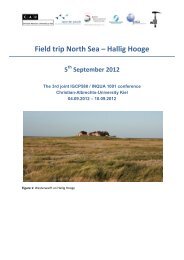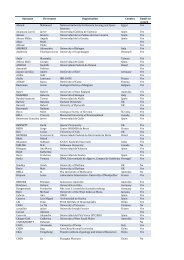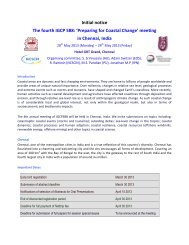Conference program and abstracts - Coastal-Change.Org
Conference program and abstracts - Coastal-Change.Org
Conference program and abstracts - Coastal-Change.Org
You also want an ePaper? Increase the reach of your titles
YUMPU automatically turns print PDFs into web optimized ePapers that Google loves.
Indian Southwest Monsoon Variability During the<br />
Holocene As Seen In The Northeastern Arabian Sea<br />
M.Ravich<strong>and</strong>ran 1 , Anil K. Gupta 1,2 <strong>and</strong> M.K. Panigrahi 1<br />
1<br />
Department of Geology <strong>and</strong> Geophysics, IIT Kharagpur, Kharagpur- 721<br />
302<br />
2<br />
Now at Wadia Institute of Himalayan Geology, Dehra Dun - 248 001<br />
E-mail: ravimrcp@gmail.com; anilg@wihg.res.in; mkp@gg.iitkgp.ernet.in<br />
ABSTRACT<br />
The Holocene epoch is of great socio-economic <strong>and</strong> academic<br />
importance, marked by significant changes in the Indian monsoon as well<br />
as global climates. The Indian summer or southwest monsoon is driven by<br />
sensible heating of the Asian l<strong>and</strong>mass <strong>and</strong> latent heat released from<br />
cross-equatorial moisture transport (Webster, 1987). In this study, 434<br />
sediment samples have been analyzed for benthic foraminifera from<br />
cores SK-240/327, SK-243/I-1 <strong>and</strong> ABP, 25/03, off Gujarat in the<br />
northeastern Arabian Sea. Our goal is to reconstruct the Holocene history<br />
of the Indian monsoon. Processed dry samples containing benthic<br />
foraminifera were sieved over 150 µm size sieve, <strong>and</strong> were split into<br />
suitable aliquots of ~ 300 specimens, identified <strong>and</strong> counted. Seasonal<br />
changes in the oceanography are reflected in benthic foraminiferal<br />
productivity. Study of 206 Core Samples from SK-243/I-1, covering a length<br />
of 3.20 meters below sea floor (mbsf) <strong>and</strong> a time span of ~11 kyrs allowed<br />
identification of 166 species of benthic foraminifera belonging to 69<br />
genera. We focused here on oceanographically important species such<br />
as Anomalina globulosa (maximum 15.63 %), followed by Uvigerina<br />
proboscidea (22.53%), Bolivina spathulata (9.38%), Gyroidinoides nitidula<br />
(17.65%), Sigmoilopsis schlumbergeri (17.55 %), Bolivina dilatata (11.04 %),<br />
Bulimina marginata (21.15 %), <strong>and</strong> Nonion cf. asterizans (24.92 %),<br />
Hyalinea balthica (8.73 %), Cancris oblongus (11.94 %), etc.<br />
The characteristic species of assemblage is Anomalina globulosa which<br />
indicates intermediate to high flux of organic matter with low oxygen<br />
deep water conditions. Uvigerina proboscidea <strong>and</strong> Bolivina spathulata<br />
indicate low oxygen, sustained flux of organic matter from high surface<br />
productivity, sluggish bottom circulation (Gupta et al., 1997).<br />
Gyroidinoides nitidula <strong>and</strong> Sigmoilopsis schlumbergeri indicate low<br />
organic carbon flux or pulsed food supply <strong>and</strong> high oxygen content of<br />
environment (Mackensen et al., 1995). Bolivina dilatata indicates high<br />
organic flux <strong>and</strong> low oxygen levels. Bulimina marginata indicates<br />
oligotrophic conditions with pulse food supply, high bottom oxygenation.<br />
Nonion cf. asterizans maintains a high abundance along with<br />
opportunistic species. Hyalinea balthica indicates high productivity, low<br />
oxygen content in bottom water (Hermelin <strong>and</strong> Shimmield, 1990). We<br />
conclude that changes in benthic foraminiferal population in the studied<br />
holes archive evidence of Southwest monsoon variability. The benthic<br />
foraminiferal data reveal that the major events occurred around ~9,000-<br />
6000 yrs suggesting a major intensification of the Indian SW monsoon. The<br />
summer monsoon was weakest during ~ 2,500 to 1,500 yrs BP. During the<br />
Medieval Warm Period the summer monsoon strengthened whereas<br />
during the most recent climatic event, the Little Ice Age, there was a<br />
drastic reduction in the intensity of the summer monsoon.<br />
Keywords: Benthic foraminifera, Indian monsoon, Arabian Sea, Holocene.<br />
The Fourth IGCP 588: PREPARING FOR COASTAL CHANGE 15





